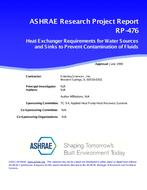Description
Increasing energy costs have created a strong interest in energy conservation techniques. Among these is the recovery of energy from refrigeration, air-conditioning and heat pump systems in order to heat potable water. Most building codes, standards and regulations require double-wall separation between the refrigerant and potable water systems even if the refrigerants and compressor oils used are considered to be non-toxic. The purpose of this study was to (a) compile and evaluate the oral toxicity data for refrigerants, compressor oils and additives, (b) rate the toxicity hazards according to a consistent system, (c) devise a separation classification system that will protect public health and safety and (d) evaluate design alternatives. The refrigerants considered include R- 11, R-12, R-22, R-113, R-114, R-115, R-152a, R-500, R-502 and R-717 (ammonia). Compressor lubricating oils evaluated included paraffinic and naphthenic mineral oils plus synthetic oils. The oral toxicity data for the refrigerants, compressor oils and additives were compiled and reviewed. The 6-level Gosselin Oral Toxicity Rating system was chosen to rate the potential hazards associated with each system. A separation classification system based upon that used in the Michigan Plumbing code was devised. It was shown that the fluorocarbon refrigerants, compressor oils and a group of selected heat transfer fluids were safe enough to use with single-wall separation. This approach, along with a set of recommendations regarding specific equipment, was recommended for incorporation in the ASHRAE Handbook and various standards.
Product Details
- Published:
- 1990
- Number of Pages:
- 110
- File Size:
- 1 file , 2.4 MB
- Product Code(s):
- D-RP-476




